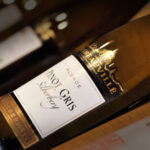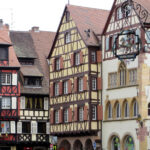 One of the best ways to have a real Portuguese experience in Lisbon is to shop like a local at the supermarket. Pick up some ingredients for dinner and learn about Portugal’s famous wine industry at the same time, without breaking the bank. The word vinho needs no explanation, but the same can’t be said for the range of Portuguese wines. Long famed for port, this small but geographically diverse country has a vast selection of tastes and styles of wine.
One of the best ways to have a real Portuguese experience in Lisbon is to shop like a local at the supermarket. Pick up some ingredients for dinner and learn about Portugal’s famous wine industry at the same time, without breaking the bank. The word vinho needs no explanation, but the same can’t be said for the range of Portuguese wines. Long famed for port, this small but geographically diverse country has a vast selection of tastes and styles of wine.
The first thing to decide is if you want red, Vinho Tinto, white, Vinho Branco or green, as in young, Vinho Verde. In addition to meaning wine, vinho also refers to table wines. Skip these and spend a few euros more to get something memorable. Vinho Regional (VR) comes from the 14 designated wine growing regions of Portugal and can contain both national and international grape varieties. With around 250 castas (grapes) indigenous to Portugal, there are way too many to list individually. Vinho DOC, short for Denominação de Origem Controlada refers to wine from strictly defined geographical areas—although currently being replaced by the pan-European DOP, Denominação de Origem Protegida. Stringent quality control measures allow only specific grapes to be grown with set maximum vine yields. There are currently 31 DOCs in Portugal.
Regions to Know
Vinho Verde
 Vinho Verde is produced in the north of Portugal from grapes grown alongside rivers traversing the mountains out to the ocean. It’s mainly a blended wine, using intense, naturally acidic Arinto, aromatic bay laurel Loureiro, subtle Alvarinho, strong fruity Azal, and the tree-fruit flavors of Trajadura grape varieties. The resulting wines have a touch of fizz and combine the chalky taste of champagne with a dry white. Rosado Vinho Verde, a rosé version, is less common but absolutely delicious.
Vinho Verde is produced in the north of Portugal from grapes grown alongside rivers traversing the mountains out to the ocean. It’s mainly a blended wine, using intense, naturally acidic Arinto, aromatic bay laurel Loureiro, subtle Alvarinho, strong fruity Azal, and the tree-fruit flavors of Trajadura grape varieties. The resulting wines have a touch of fizz and combine the chalky taste of champagne with a dry white. Rosado Vinho Verde, a rosé version, is less common but absolutely delicious.
Porto and Duoro
The UNESCO World Heritage hand-carved terraces lining the hills along the Duoro River in northern Portugal have been cultivated for thousands of years. Famous for producing port wines, the best ones use a blend of national grape varieties such as dense, fragrant, velvety tannin Touriga Franca, intensely fruity and aromatic Touriga Nacional and robust, spicy berry flavor Tinta Roriz (called Aragonês in Alentejo). Of the three types of port, ruby is the cheapest and best drunk young as a sweet aperitif. Tawny ports are aged in wooden barrels. They’re either Colheita, specifying vintage, or Aged, with the number of years specified on the label. Ten-year-old port is a solid choice, but should be finished three months after opening. White port is refreshing to drink in summer mixed with tonic water.
Duoro wines include full-bodied Tinto Douro using Touriga Nacional, and Douro Branco, using aromatic Malvasia Fina, with hints of molasses, beeswax and nutmeg.
Dão
Nestled among high mountains, the sheltered Dão region experiences cool nights that make the grapes ripen slowly, resulting in good acidity and aromatics. The most popular red wines are the full-bodied Dão Touriga Nacional, the berry flavored Dão Jaen and fruity, aromatic Alfrocheiro. The best whites are made from Encruzado grapes and range from light and fresh to more intense, richer barrel-fermented styles.
Bairrada

Bordered by ocean and mountains, the mainly hilly Bairrada region has a mild climate with abundant rainfall. Bairrada Classico, made from 100% local grape Baga, a long-lived, intense tannin rich variety, was originally the main red wine produced here. It’s largely been replaced by a much wider variety of Tinto Bairrada, ranging from heavy blackberry to delicate light fruity wines. Bairrada is also home to Branco Bairrada. The aromatic white can be made from Fernão Pires (the local name is Maria Gomes), a grape with low to medium acidity and intense floral flavors, orArinto. The sparkling variety uses Baga, Fernão Pires and others.
Beira Interior
Close to the Spanish border, the Beira Interior has extremely hot, dry summers and long cold winters. It’s a challenging climate for growing grapes but is home to many old vines. Tinto Beira are made from Alfrocheiro, rich dark spicyTrincadeira and Touriga Nacional. Bastardo, of French origin, and Murufo, an old Portuguese variety, are also used. Arinto are used in Branco Beira to produce chalky white wines, as is citrusy Síria (the regional name for Roupeiro).
Lisboa
Originally called Estremadura, grape production in the Lisboa region dates back thousands of years. This long thin strip of land bounded by ocean on one side and mountains on the other has a mixed climate and boasts nine DOCs. Some of the best Lisboa wines include Alenquer DOC, a high tannin red wine usually consisting of Alfrocheiro, Aragonês (called Tinta Roriz in Duoro), deep complex Castelão and Touriga Nacional. Arruda DOC blends local grapes with non-indigenous Cabernet Sauvignon and Syrah. Torres Vedras DOC uses the red-fleshed Alicante Bouschet along with national varieties of grape. Bucelas DOC is made with a minimum of 75% Arinto grapes to produce a light-bodied, crisp mineral white.
 The windy and cool conditions of Óbidos, near Peniche on the coast, are perfect for producing sparkling wines using Fernão Pires.
The windy and cool conditions of Óbidos, near Peniche on the coast, are perfect for producing sparkling wines using Fernão Pires.
Tejo
Located inland from Lisboa, the Tejo region consists of flat planes known for producing well-balanced, affordable wines. Once called Ribatejo, wine production here dates to Roman times. Portugal’s most famous red varietal, Touriga Nacional, is native to the Tejo terroir, as are Trincadeira, Castelão and Aragonês. White wines made from Fernão Pires and Arinto have a refreshing, fruity characteristic.
Peninsula de Setúbal
South of Lisbon on the other side of the Tagus River, the Setúbal peninsula has a Mediterranean climate with hot summers and mild rainy winters. Two DOCs are found here. DOC Palmela are red wines made from the Castelão grape. But the region is most famous for Moscatel de Setúbal, which contains more than 85% Muscat of Alexandria grape. Drunk young, this sweet fragrant wine makes a good aperitif while mature muscatel has a nutty, toffee-like taste.
Alentejo
Slightly confusingly, wines here can be labelled Alentejano VR, but only the DOC wines get the name Alentejo. The dry, largely flat terrain of this region is always hot in summer and brutally cold in winter. Aragonês is the most widely planted red grape and is used with others grown in subregionsÉvora, Redondo and Reguengos. One third of all winemakers in Portugal operate here, many of them small experimental wineries. They produce full-bodied red wines with rich fruit and mocha flavors using the local grapes, as well as Touriga Nacional, Trincadeira, Castalão, and Cabernet Sauvignon and Syrah.
The region’s white wines are made from grape varieties such as Antão Vaz, which boasts notes of tropical fruits, tangerine peel and minerals, Arinto, and citrus, floral Roupeiro (its local name is Alva). Generally Branco Alentejo is sweet, quite floral, and often both.
And Beyond
Although there are five other wine regions in Portugal, they don’t always appear on the shelves of all the major supermarkets. When they do, the selection can be quite small. Trás-Os-Monte in the north east is known for its reds. Távora-Varosa, a small mountainous region in the east, produces sparkling wines. While the Algarve on the Mediterranean coast is home to four DOCs, generally the wines are outclassed by other regions, although this is beginning to change. Wines made in The Azores are generally only available there. Madiera gives its name to a fortified wine made from the Tinta Negra grape, that has a distinctive sweetness. There will normally be at least one Madiera available in most stores.
Whatever your preferred drop, drinking a glass of Portuguese wine while gazing over Lisbon from one of city’s famous miradouro(scenic viewing platforms), is the perfect end to a day’s exploring. Saúde!
 Lisa Morrow is a Sydney born sociologist, travel writer, and author of three books about her life and travels in Istanbul and Turkey. She currently splits her time between Istanbul and Lisbon and writes about food, wine, culture and travel for print magazines and websites. When Lisa isn’t writing she’s sampling as many different types of red wine as possible, trying to learn Portuguese and daydreaming about her next travel destination.
Lisa Morrow is a Sydney born sociologist, travel writer, and author of three books about her life and travels in Istanbul and Turkey. She currently splits her time between Istanbul and Lisbon and writes about food, wine, culture and travel for print magazines and websites. When Lisa isn’t writing she’s sampling as many different types of red wine as possible, trying to learn Portuguese and daydreaming about her next travel destination.



